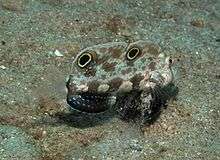Signigobius biocellatus
| Signigobius biocellatus | |
|---|---|
 | |
| Not evaluated (IUCN 3.1) | |
| Scientific classification | |
| Kingdom: | Animalia |
| Phylum: | Chordata |
| Class: | Actinopterygii |
| Order: | Perciformes |
| Family: | Gobiidae |
| Subfamily: | Gobiinae |
| Genus: | Signigobius Hoese & G. R. Allen, 1977 |
| Species: | S. biocellatus |
| Binomial name | |
| Signigobius biocellatus Hoese & G. R. Allen, 1977 | |
Signigobius biocellatus,[1] the Twin-spot Goby or Crab-eyed Goby, is a species of goby native to the Western Pacific Ocean where they can be found in areas of sand, silt in lagoons, or coastal bays with nearby cover such as rubble, coral, or leaf litter. They can be found at depths of from 1 to 30 metres (3.3 to 98.4 ft). This species can reach a length of 10 centimetres (3.9 in) SL. It can also be found in the aquarium trade. It is currently the only known member of its genus.[2]
References
- ↑ "Twinspot goby - Signigobius biocellatus - Aquarium Advice". www.aquariumadvice.com. Retrieved 2015-10-01.
- ↑ Froese, Rainer and Pauly, Daniel, eds. (2013). "Signigobius biocellatus" in FishBase. June 2013 version.
| Wikimedia Commons has media related to Signigobius biocellatus. |
This article is issued from Wikipedia - version of the 10/1/2015. The text is available under the Creative Commons Attribution/Share Alike but additional terms may apply for the media files.